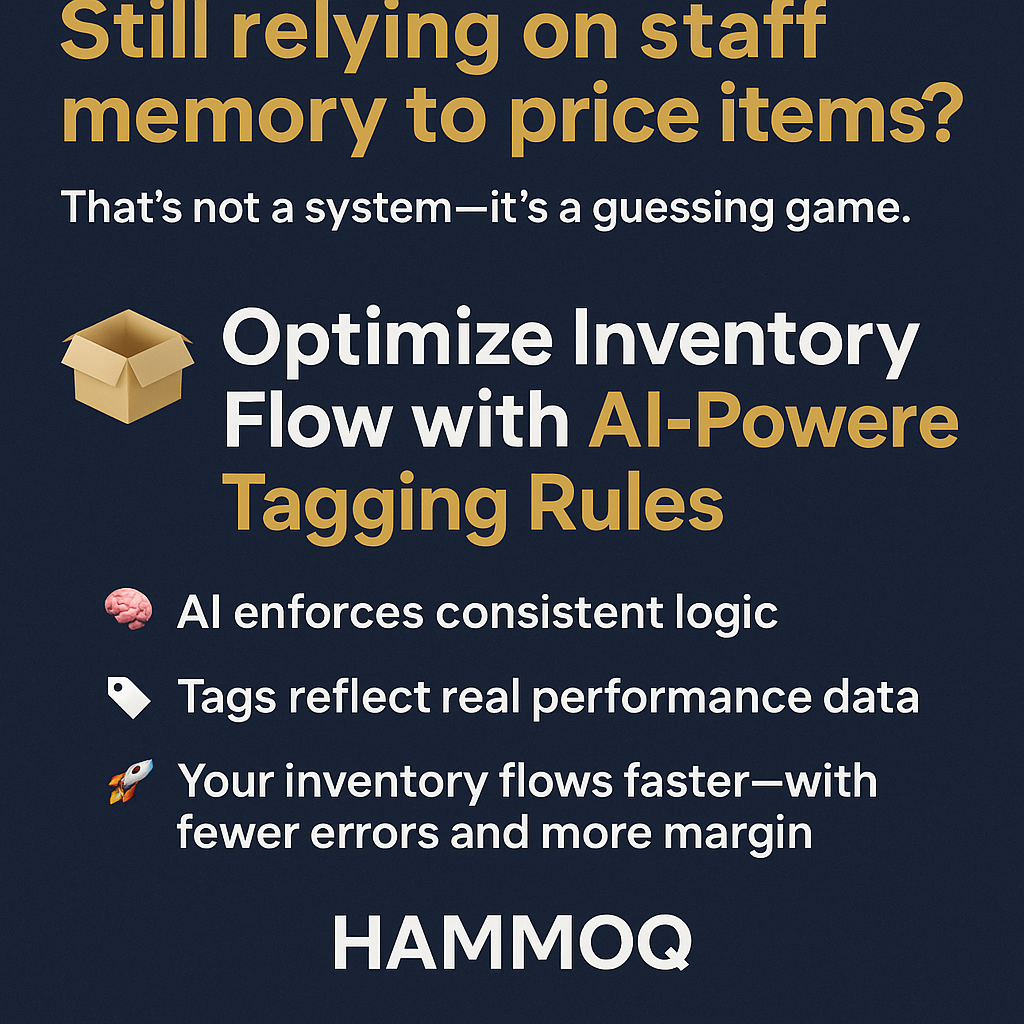
TL;DR Summary:
Hammoq lets you define category, condition, and price logic once—then applies it consistently across every tag.
Tagging is the heartbeat of resale operations—but for most stores, it’s based on guesswork, not logic.
Walk into any backroom and you’ll see it:
- One team member pricing shoes at $4.99
- Another tagging similar pairs at $14.99
- New hires asking, “What’s this worth?”
- Store managers referencing old charts—or just going with their gut
Hammoq replaces that inconsistency with smart tagging rules backed by data.
With AI-powered pricing and tagging logic, Hammoq ensures:
✅ Consistency across teams and locations
✅ Logic based on performance—not opinion
✅ Scalability without needing tribal knowledge
🧠 Why Inconsistent Tagging Hurts Revenue
Let’s break it down.
When tagging is inconsistent:
- High-value items get underpriced → lost margin
- Low-demand inventory is overpriced → sits too long
- Staff wastes time asking “what do we usually price this at?”
- Store-to-store pricing becomes a mess
- Performance is hard to track and improve
The result?
Slow turnover. Lost sales. Missed margin.
In short, every bad tag slows your floor.
💡 How Hammoq Fixes the Tagging Process
Hammoq gives you a centralized tagging rule engine that’s AI-enhanced and fully customizable.
Here’s how it works:
✅ Step 1: Define Tagging Rules
Set the logic that works for your business:
- Pricing tiers by condition (Good / Better / Best)
- Categories that matter to your margins (denim, outerwear, shoes)
- Brand-level rules (e.g., Nike > $12.99 if condition = Better)
- Floor vs. online channel guidance
✅ Step 2: Train the System with Past Data
Hammoq analyzes:
- Your store’s historical average sale price (ASP)
- Sell-through rate by item type
- Seasonal performance and category velocity
- Location-based demand trends
It combines your insights + its AI to suggest optimized tagging logic.
✅ Step 3: Apply Automatically
Once tagging rules are configured:
- Hammoq applies them instantly at intake
- Staff simply takes a photo or scans a barcode
- AI evaluates item attributes and prints the right tag
Whether a veteran manager or a new hire is on shift—your pricing logic is enforced every time.
✅ Key Takeaways:
- Remove pricing guesswork across teams
Say goodbye to staff debates and inconsistent decisions. - Ensure consistent tagging and margin retention
Protect your high-ASP items and move low-performers quicker. - Scale operations with built-in logic
Onboard new locations or employees faster—with no manual training needed.
🔁 Before vs. After Hammoq:
Before:
- Tags vary wildly by employee or location
- Analysts waste time fixing inconsistent pricing
- New hires need weeks of training
- High-value items priced too low
- Overstock lingers from poor price judgment
After:
- Consistent tags from day one
- Automated, store-specific pricing logic
- Training time cut in half
- Sell-through improves from smarter pricing
- Staff productivity increases without sacrificing control
📊 Real-World Impact Example:
Let’s say you process 1,000 items per week.
If 20% are tagged inconsistently:
- 100+ items either lose margin or sit unsold
- At an average margin loss of $3/item → $300/week lost
- Over 52 weeks → $15,600 per location
Even modest improvements in tag accuracy can unlock tens of thousands in revenue annually.
🛍️ Who Should Use Smart Tagging Rules:
- Multi-location thrift or resale chains
- Consignment franchises with rotating staff
- Liquidation centers needing consistent workflows
- Donation-based stores managing high volumes
- Any store struggling with onboarding or inventory variance
🚀 What’s Next (How To):
- Define tagging logic for your top 5 categories
Start with high-volume or high-margin items (e.g., denim, outerwear). - Deploy Hammoq rules across stores or team members
Ensure consistent tagging whether it's Store A or Store Z. - Track item performance by tag source
Use reporting to fine-tune rules and improve both margin and sell-through.




